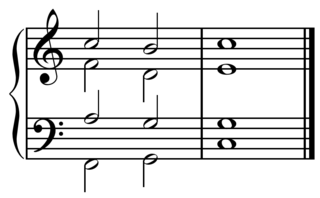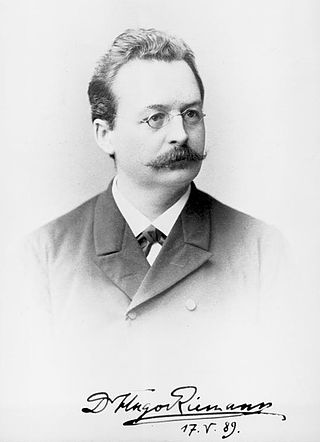
In music, harmony is the concept of combining different sounds together in order to create new, distinct musical ideas. Theories of harmony seek to describe or explain the effects created by distinct pitches or tones coinciding with one another; harmonic objects such as chords, textures and tonalities are identified, defined, and categorized in the development of these theories. Harmony is broadly understood to involve both a "vertical" dimension (frequency-space) and a "horizontal" dimension (time-space), and often overlaps with related musical concepts such as melody, timbre, and form.

Music theory is the study of the practices and possibilities of music. The Oxford Companion to Music describes three interrelated uses of the term "music theory": The first is the "rudiments", that are needed to understand music notation ; the second is learning scholars' views on music from antiquity to the present; the third is a sub-topic of musicology that "seeks to define processes and general principles in music". The musicological approach to theory differs from music analysis "in that it takes as its starting-point not the individual work or performance but the fundamental materials from which it is built."

Tonality is the arrangement of pitches and/or chords of a musical work in a hierarchy of perceived relations, stabilities, attractions and directionality. In this hierarchy, the single pitch or triadic chord with the greatest stability is called the tonic. The root of the tonic chord forms the name given to the key, so in the key of C major, the note C can be both the tonic of the scale and the root of the tonic chord. The tonic can be a different note in the same scale, when the work is said to be in one of the modes of the scale.

Eduard Hanslick was an Austrian music critic, aesthetician and historian. Among the leading critics of his time, he was the chief music critic of the Neue Freie Presse from 1864 until the end of his life. His best known work, the 1854 treatise Vom Musikalisch-Schönen, was a landmark in the aesthetics of music and outlines much of his artistic and philosophical beliefs on music.
In music, the submediant is the sixth degree of a diatonic scale. The submediant is named thus because it is halfway between the tonic and the subdominant or because its position below the tonic is symmetrical to that of the mediant above.
In music, function is a term used to denote the relationship of a chord or a scale degree to a tonal centre. Two main theories of tonal functions exist today:

Karl Wilhelm Julius Hugo Riemann was a German musicologist and composer who was among the founders of modern musicology. The leading European music scholar of his time, he was active and influential as both a music theorist and music historian. Many of his contributions are now termed as Riemannian theory, a variety of related ideas on many aspects of music theory.
The Tristan chord is a chord made up of the notes F, B, D♯, and G♯:
Song structure is the arrangement of a song, and is a part of the songwriting process. It is typically sectional, which uses repeating forms in songs. Common forms include bar form, 32-bar form, verse–chorus form, ternary form, strophic form, and the 12-bar blues. Popular music songs traditionally use the same music for each verse or stanza of lyrics. Pop and traditional forms can be used even with songs that have structural differences in melodies. The most common format in modern popular music is introduction (intro), verse, pre-chorus, chorus, verse, pre-chorus, chorus, bridge, and chorus. In rock music styles, notably heavy metal music, there is usually one or more guitar solos in the song, often found after the middle chorus part. In pop music, there may be a guitar solo, or a solo performed with another instrument such as a synthesizer or a saxophone.

Percy Goetschius was an American music theorist and teacher who won international fame in the teaching of composition.

Music psychology, or the psychology of music, may be regarded as a branch of both psychology and musicology. It aims to explain and understand musical behaviour and experience, including the processes through which music is perceived, created, responded to, and incorporated into everyday life. Modern music psychology is primarily empirical; its knowledge tends to advance on the basis of interpretations of data collected by systematic observation of and interaction with human participants. Music psychology is a field of research with practical relevance for many areas, including music performance, composition, education, criticism, and therapy, as well as investigations of human attitude, skill, performance, intelligence, creativity, and social behavior.

Jacob Gottfried Weber was a prominent German writer on music, composer, and jurist.
In music theory, Roman numeral analysis is a type of musical analysis in which chords are represented by Roman numerals. In some cases, Roman numerals denote scale degrees themselves. More commonly, however, they represent the chord whose root note is that scale degree. For instance, III denotes either the third scale degree or, more commonly, the chord built on it. Typically, uppercase Roman numerals are used to represent major chords, while lowercase Roman numerals are used to represent minor chords. However, some music theorists use upper-case Roman numerals for all chords, regardless of chord quality.
Bernd Redmann is a German composer and musicologist.
Culture in music cognition refers to the impact that a person's culture has on their music cognition, including their preferences, emotion recognition, and musical memory. Musical preferences are biased toward culturally familiar musical traditions beginning in infancy, and adults' classification of the emotion of a musical piece depends on both culturally specific and universal structural features. Additionally, individuals' musical memory abilities are greater for culturally familiar music than for culturally unfamiliar music. The sum of these effects makes culture a powerful influence in music cognition.

Research into music and emotion seeks to understand the psychological relationship between human affect and music. The field, a branch of music psychology, covers numerous areas of study, including the nature of emotional reactions to music, how characteristics of the listener may determine which emotions are felt, and which components of a musical composition or performance may elicit certain reactions.
The psychology of music preference is the study of the psychological factors behind peoples' different music preferences. Music is heard by people daily in many parts of the world, and affects people in various ways from emotion regulation to cognitive development, along with providing a means for self-expression. Music training has been shown to help improve intellectual development and ability, though no connection has been found as to how it affects emotion regulation. Numerous studies have been conducted to show that individual personality can have an effect on music preference, mostly using personality, though a recent meta-analysis has shown that personality in itself explains little variance in music preferences. These studies are not limited to American culture, as they have been conducted with significant results in countries all over the world, including Japan, Germany, Spain, and Brazil.
The history of emotions is a field of historical research concerned with human emotion, especially variations among cultures and historical periods in the experience and expression of emotions. Beginning in the 20th century with writers such as Lucien Febvre and Peter Gay, an expanding range of methodological approaches is being applied.

Parallel and counter parallel chords are terms derived from the German to denote what is more often called in English the "relative", and possibly the "counter relative" chords. In Hugo Riemann's theory, and in German theory more generally, these chords share the function of the chord to which they link: subdominant parallel, dominant parallel, and tonic parallel. Riemann defines the relation in terms of the movement of one single note:
The substitution of the major sixth for the perfect fifth above in the major triad and below in the minor triad results in the parallel of a given triad. In C major thence arises an apparent A minor triad, D minor triad (Sp), and E minor triad (Dp).
Ludwig Holtmeier is a German music theorist and piano player.









